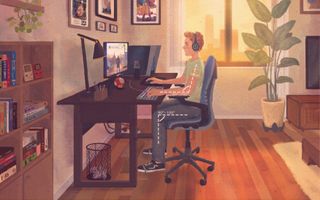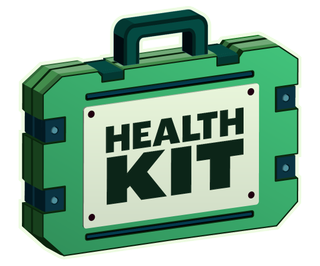How to sit at a desk with good posture
Improve your posture and reap the rewards, with advice from an ergonomist and a physical therapist.

Office chairs don't occur in nature, and so it follows that there's no automatic, 'natural' way to sit in one. But there are good and bad ways to sit at a desk, and sitting better can increase your long-term comfort and decrease your risk of developing back pain or other problems related to poor ergonomics. Your sitting and standing posture can affect everything from breathing to how likely you are to injure yourself.
I'd also argue that correcting bad sitting habits can make you better at competitive games. When your setup allows for a balanced posture with no strain or pinched nerves, you'll be less distracted. And for shooters, good ergonomics means having a great range of control over your mouse arm.
If you don't notice any benefits from good posture—which doesn't necessarily mean you're not getting any—you won't have lost anything by correcting it except for a bit of time and concentration. And if an ergonomist happens to walk by you, you'll get a pat on the back for sitting properly, so that's a plus.

How to sit at a desk
Whether you're working or playing games, below are our basic recommendations for sitting at a desk:
- Your knees should be bent at 90 degrees, and your feet flat on the floor.
- Your elbows should be level with your desk and close to your body (meaning that you shouldn't have to extend your arms to reach your mouse and keyboard).
- Your shoulders should be relaxed.
- Your lower back should be supported. If your chair doesn't have built-in lumbar support, a small pillow can do the job.
- Your monitor should positioned such that you don't have to tilt your head up.
These guidelines are based on a conversation with ergonomist Melissa Afterman from 2015. They also have a thumbs up from physical therapist Dr Caitlin McGee, who specializes in gaming-related health at 1HP Gaming. (Dr McGee has also written about the causes of chronic wrist pain and what to do about it on PC Gamer.)
Adopting these rules can help avoid unnecessary strain and pinching. If it all feels weird and uncomfortable at first, give it time, because your muscles need to adjust to new habits. (Exercising those muscles could help, too—more on that shortly.)
How and when to change it up
If we're being honest, none of us are likely to maintain a 'perfect' sitting position at all times, even if we know all the rules. The good news is that we shouldn't do that anyway. McGee has another rule for sitting: "Your best posture is your next posture."
The biggest gaming news, reviews and hardware deals
Keep up to date with the most important stories and the best deals, as picked by the PC Gamer team.

Health Kit is PC Gamer's coverage of health, ergonomics, and wellness, which is currently being produced with support from AMD. Throughout the rest of 2020, we'll be publishing more health-related articles and videos with advice from specialists. More:
How to configure your mouse so it doesn't hurt you
What should I do if I have wrist pain?
9 simple ways to make your desk healthier and more comfortable
5 ways to avoid hurting yourself while PC gaming
Even if you're sitting in the ergonomist-recommended way, you shouldn't stay in that exact position for hours at a time. For example, McGee suggests that you could switch to a cross-legged position for a while, just as long as you stick with the other principles, such as keeping your back supported and your shoulders relaxed. My chair reclines, so I sometimes lean back to think, but I don't continue typing from that position, which would require that I extend my arms.
As a general rule, McGee advises against sitting in any position that makes it difficult to take deep breaths. "If you can't breathe easily, it's probably not a great position for your back," she says. When in doubt that's a great, simple rule to follow.
If you're able, an adjustable sitting/standing desk allows you to take a break from sitting without stopping what you're doing. Otherwise, get away from your desk now and then, and stretch if you can. (Breaks are good for other reasons, too.)
A few years ago, Eric Robertson, Kaiser Permanente of Northern California's director of graduate physical therapy education, told our friends at LiveScience that adjusting your position every 20 minutes makes for a good cadence.
Above: This PC Gamer Show episode from 2015 still contains relevant advice.
Other ways to help your back
I asked McGee about the effects of sitting on a thick wallet, which tilts the pelvis and puts strain on the lower back. "You could develop pain, patterns of alternately tight or weak muscles, and even altered breathing patterns," as a result of that kind of habit (among other things). But don't panic if you've spent years with a pile of receipts jammed into your back pocket, like I have.
"The body is remarkably adaptable," says McGee, "and while it takes about 8 weeks of training to start to see actual muscle growth, you can start to see changes in the connection between the brain and the muscle (neuromuscular development) much sooner."
By correcting a bad habit, a "healthier, less-painful back with better posture" can be our reward in just one-to-two weeks, but only if we're establishing other good habits and doing "endurance, strength, and stretching exercises" to support the time we spend sitting, she says.
The sooner you address those deficits, the easier they are to resolve.
Yeah, I'm afraid we're supposed to exercise, too, because if posture isn't the sole cause of back problems, it follows that it's also not the sole fix. "More often, [lower back pain is caused by] a pattern that involves deficits in strength, mobility, and endurance," says McGee. "The longer those deficits persist, the more likely you are to develop pain and maladaptive compensations. The sooner you address those deficits, the easier they are to resolve."
1HP Gaming frequently posts advice to its blog, including exercise tips and routines. As always, be cautious about adopting new exercise routine, especially if you have any medical conditions—if you're unsure about anything, consult with a doctor.
If you've got the budget for it, another way to help out your back is to invest in a good desk chair. While some are super expensive, such as the $900-plus Steelcase Gesture, others are a bit more reasonable, like the $359 Secret Lab Omega. That's still not cheap, but it should last, and the difference between even a decent chair and a bad one is huge. If you need to find something less expensive, though, the most important thing to look for is adjustability. If you can't adjust the height or other aspects, you'll have a hard time getting into a good position for your body.
And if you do sit with a thick wallet in your back pocket, as I did for a very long time, you can do yourself a favor by finding somewhere else to stash it while you're at your desk. A 2014 study on the "effect of wallet thickness on spine posture, seat interface pressure, and perceived discomfort during sitting" concluded that "asymmetrical sitting is not recommended, even for short duration exposures." After I stopped sitting on my wallet, I noticed very quickly that I felt more balanced and noticed less lower back strain. Now I'm only tilted because of how bad I am at Rainbow Six Siege, not because of a stack of expired debit cards.

Tyler grew up in Silicon Valley during the '80s and '90s, playing games like Zork and Arkanoid on early PCs. He was later captivated by Myst, SimCity, Civilization, Command & Conquer, all the shooters they call "boomer shooters" now, and PS1 classic Bushido Blade (that's right: he had Bleem!). Tyler joined PC Gamer in 2011, and today he's focused on the site's news coverage. His hobbies include amateur boxing and adding to his 1,200-plus hours in Rocket League.
Most Popular





